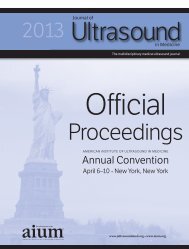Abdominal Aorta - AIUM
Abdominal Aorta - AIUM
Abdominal Aorta - AIUM
- No tags were found...
Create successful ePaper yourself
Turn your PDF publications into a flip-book with our unique Google optimized e-Paper software.
I. IntroductionThe clinical aspects contained in specific sections of thisguideline (Introduction, Indications/Contraindications,Specifications of the Examination, and EquipmentSpecifications) were developed collaboratively by theAmerican Institute of Ultrasound in Medicine (<strong>AIUM</strong>),the American College of Radiology (ACR), and the Societyof Radiologists in Ultrasound (SRU). Recommendationsfor physician requirements, written request for the examination,procedure documentation, and quality controlvary among the three organizations and are addressedby each separately.These guidelines are intended to assist in the performanceand interpretation of a dedicated sonographic examinationof the abdominal aorta. The examination may be performedas a diagnostic or screening study. Comprehensivepopulation screening programs have not yet been developedin the United States but do exist elsewhere in theworld. 1,2 While it is not possible to detect every abnormality,following this guideline will maximize the detection ofabnormalities of the abdominal aorta.II. Qualifications and Responsibilities ofPersonnelSee www.aium.org for <strong>AIUM</strong> Official Statements includingStandards and Guidelines for the Accreditation ofUltrasound Practices and relevant Physician TrainingGuidelines.III. Indications/ContraindicationsIndications for ultrasound of the abdominal aorta includebut are not limited to:A. Diagnostic Evaluation for an <strong>Abdominal</strong> AorticAneurysm1. Palpable or pulsatile abdominal mass.2. Unexplained lower back pain, flank pain, orabdominal pain.3. Follow-up of a previously demonstrated abdominalaortic aneurysm.4. Follow-up of patients with an abdominal aorticand/or iliac endoluminal stent graft.B. Screening Evaluation for an <strong>Abdominal</strong> AorticAneurysm1. Men 65 years or older.2. Women 65 years or older with cardiovascular riskfactors.3. Patients 50 years or older with a family historyof aortic and/or peripheral vascular aneurysmaldisease.4. Patients with a personal history of peripheralvascular aneurysmal disease.Groups with additional risk include patients with a historyof smoking, hypertension, and certain connective tissuediseases (eg, Marfan syndrome).There are no absolute contraindications to ultrasoundof the aorta. If aortic rupture or dissection is clinicallysuspected, ultrasound is usually not the examinationof choice.IV. Written Request for the ExaminationThe written or electronic request for an ultrasound examinationshould provide sufficient information to allow forthe appropriate performance and interpretation of theexamination.The request for the examination must be originated by aphysician or other appropriately licensed health careprovider or under their direction. The accompanying clinicalinformation should be provided by a physician orother appropriate health care provider familiar with thepatient’s clinical situation and should be consistent withrelevant legal and local health care facility requirements.V. Specifications of the ExaminationA. Diagnostic ExaminationThe examination includes the following, when feasible:1. <strong>Abdominal</strong> aorta:a. Longitudinal images (along the long axis ofthe vessel):i. Proximal;ii. Mid;iii. Distal.Effective March 27, 2010—<strong>AIUM</strong> PRACTICE GUIDELINES—<strong>Abdominal</strong> <strong>Aorta</strong> in Adults 1
















